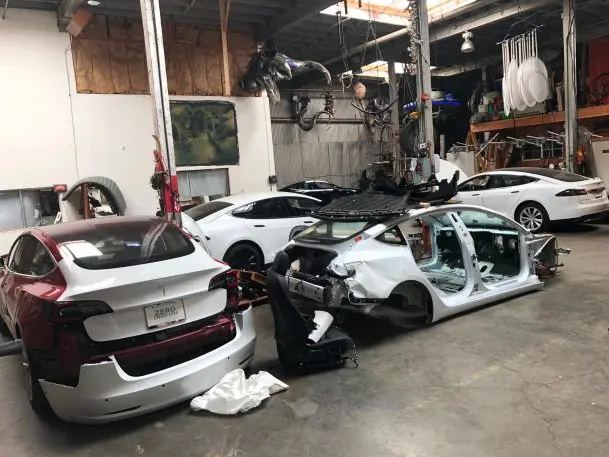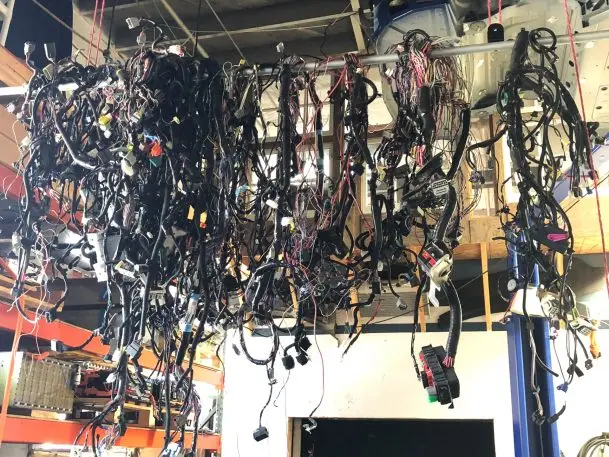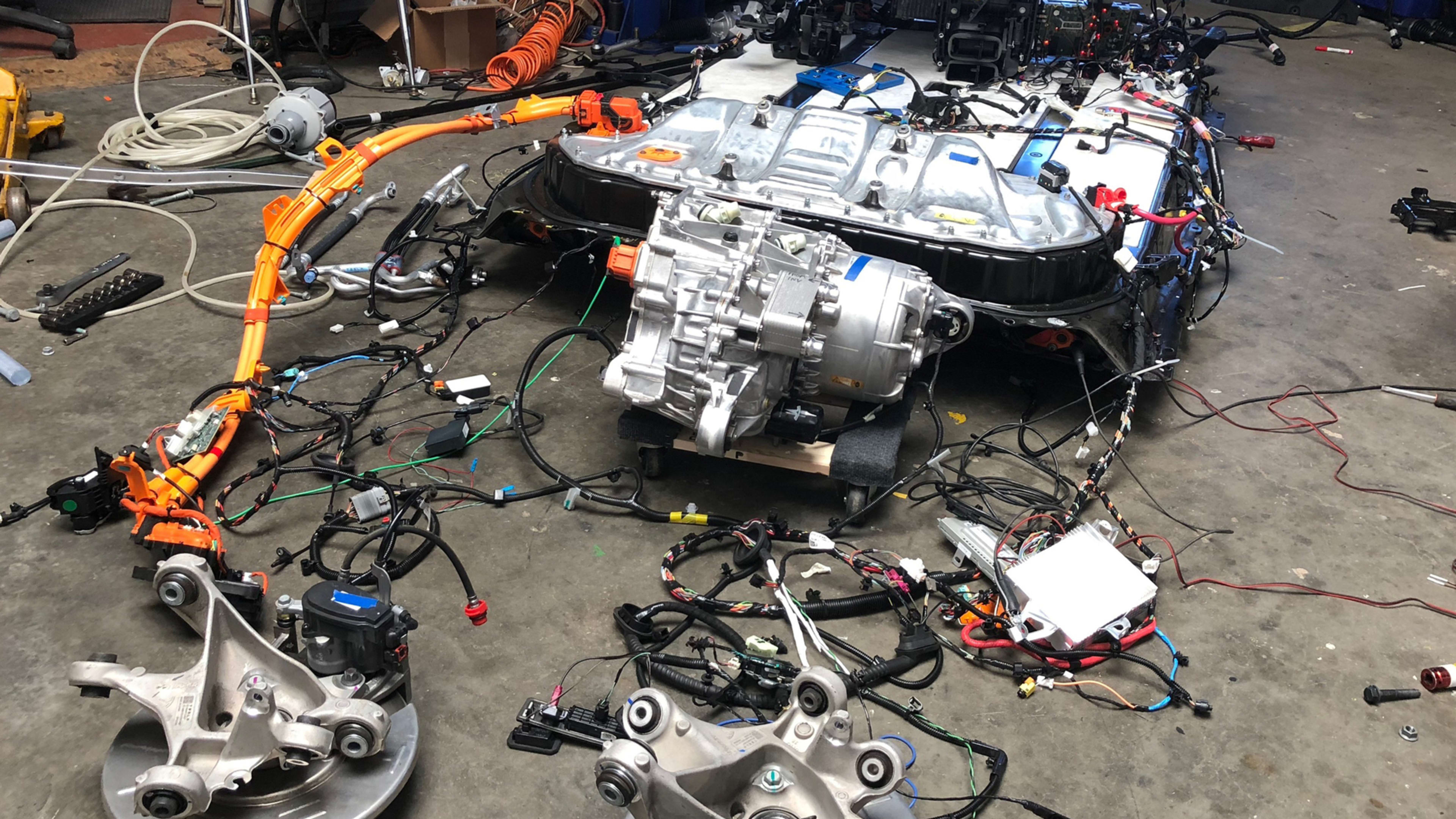In a cramped warehouse in an industrial neighborhood in Berkeley, California, a Tesla Model 3 is ready to go. It’s powered up, its display screen is on, and it’s pumping out data. But there are some strange error messages. For one, the passenger door window is uncalibrated. For another, the autopilot electronic control unit is missing.
These would be troubling signals for most Tesla owners. For Phil Sadow, though, they make perfect sense. After all, his Model 3 is lacking some very important components: its windows, its wheels, and the entire body frame.
For the last three years, Sadow, a 49-year-old electrical engineer who also goes by the moniker Ingineer, has been rebuilding and selling salvaged Teslas. He’s also taught a global community of fellow enthusiasts to do the same, charging an hourly rate as a consultant on other tinkerers’ repair projects. All told, he says, he’s rebuilt—or helped other people rebuild—almost 400 vehicles over the last three years.
That might not seem all that notable given that there are millions of salvaged cars of every make and model in operation. But Teslas are different: Elon Musk’s company absolutely doesn’t want its cars back on the roads if they’ve been in serious accidents. In fact, according to Sadow, Tesla specifically aims to make it next to impossible to repair them.
“When a car is totaled,” he says, “they deny parts, [and] they don’t in any way give service information, the service tools like all the electronics and computer stuff needed to work on the cars . . . except where they’re required to by law. And even then they don’t do that.”
Sadow understands why Tesla doesn’t want its cars put back on the road after a major accident: They’re lightning rods for attention. “Tesla’s trying to protect their stock price and their mission by eliminating some of this,” he says. “If I buy a salvage car and fix it improperly and it kills someone somehow or burns a house down . . . it’s not going to be ‘Man fixes Tesla improperly and hurts someone.’ It’s going to be ‘Tesla kills someone.'”
A big fan of Tesla’s mission of putting large numbers of high-quality electric cars on the road, Sadow worries that the company’s policy of making it difficult to repair badly damaged vehicles is short-sighted. Over time, he argues, the lack of a market for salvaged Teslas will mean very expensive insurance premiums. And that could badly undermine the company’s mission. “It’s one thing on a $120,000 Model S to have a high insurance,” he says. “But on a mass-market $35,000 car [the Model 3], if half your car payment’s insurance, it’s not going to fly. If this continues and they don’t adjust their policy, that’s what the insurance market’s going to do. It’s the only way they can make their money. ”
Tesla is exacerbating the problem by not adhering to Right to Repair laws in states such as Massachusetts that require them to provide owners with things like service manuals, Sadow argues. Even in such states, he says, the company is refusing to give out such information for the Model 3, although it does for the older Model S.
Tesla declined to comment for this article but did provide some background information. Essentially, a spokesperson told me, the company will inspect salvaged vehicles for a fee to assess what repairs might be needed to get them running again. Tesla believes there are substantial safety concerns associated with unqualified mechanics working on such cars.

Accidents happen
Tesla’s Model 3, its long-awaited, relatively affordable, and hard-to-get sedan, has only been available since the summer of 2017. So I was mildly surprised when I saw two badly damaged Model 3s in Sadow’s warehouse. But I shouldn’t have been. There are probably 50,000 examples of the car already in the wild. Of course some of them are getting in accidents. He thinks they probably get in fewer crashes than normal cars because of all the built-in driver-assist technology, but nevertheless they show in salvage auctions.
The very first salvaged Model 3s cost a lot at auction: One was bought by a Tesla competitor that wanted to tear it apart and analyze it, Sadow says. But “after the first few weeks, the prices started to come down, because no one knows what to do with these cars.”
When most vehicles are totaled, they end up in insurance auctions, where they’re purchased by everyone from individual body shops to large businesses that fix them up and sell them, either as functional vehicles or for parts. It’s a thriving business, Sadow says, that makes for a healthy secondary market for vehicles. The important thing is that this ecosystem lets insurance companies recoup a substantial part of what they have to pay to replace the original owners’ cars.
However, because of Tesla’s policies, Sadow argues, the market for salvaged examples of its vehicles is slim, resulting in a chicken-and-egg situation. Individual buyers can’t easily get parts, and there are too few totaled Teslas available for body shops to pay much attention. “The insurance underwriters figured it out,” he says: “‘Oh, it’s a Tesla, we’re going to eat our lunch on these.’ So they start raising premiums. A lot of insurers consider the Model S and the Model X exotics, like a Ferrari. For that reason, because they’re losing their shirt on even relatively minor accidents.”
Tesla, deconstructed
All of this explains why Sadow was able to buy his Model 3, the one that’s sitting on the floor of his warehouse, for about 25% of its non-salvage market value. The so-called car is amazing to look at. Laid out on the floor, it’s a working collection of the vehicle’s components, with its mangled and emptied-out body in the room next door. Its display screen is turned on and the car thinks it’s operational, even to the point of being able to power up the motor, give or take a few pesky error messages. Sadow is using it as a test bed, and spent weeks digging deep into the car’s electronics to figure out how it all works. “I can do analysis of all the systems,” he says, “learn what I need to be able to understand, like when the diagnostics tells you [something] isn’t working right, what is that system, how does that work, where it is located in the car? Since we have no service information, I have to kind of construct all of that in reverse to understand.”
Sadow first began working on Teslas in 2015 when his girlfriend was facing a hellacious daily commute to Silicon Valley and wanted an electric car, which would offer both fuel economy and the ability to drive in the carpool lane. He found a Model S with damaged electronics that had been in a flood in Houston, but whose body was in fine shape. It smelled like gym socks, so over a few weeks, the two of them took the whole car apart, cleaned it all up, got rid of all the mold, and then put it back together again. For some time, she drove it to work every day. In the end, though, he sold it to a friend.
Then he seized the opportunity and began regularly buying, fixing, and selling salvaged Teslas. That was in part because he met a guy in online Tesla forums who owned a body shop in Minneapolis, and the two began working together on the cars–Sadow would repair their electronics and systems, and his partner would fix the bodies. They would then sell them within a network of friends and family. Sadow won’t say what he charges for these revived Teslas, but it’s much closer to the non-salvage market value than the lowball prices he pays.
That partnership exists to this day, and the two are currently working on a second Model 3 that sits in the warehouse in Berkeley. Its red body is in pretty good shape, and once Sadow finishes the systems work and locates the remaining parts needed to get it back in drivable shape, he’ll put it on a truck bound for Minnesota. As for the disembodied Model 3 on his floor, Sadow plans on using its guts to hack together another vehicle once he’s finished analyzing the car’s systems.
With more and more Model 3s on the roads, Sadow expects there will soon be quite a number of them available for next to nothing at insurance auctions. “There will be people that want to know how to work on them,” he says, “and that’s basically my full-time job now–helping other people work on these cars.”
Sadow has poured his knowledge into his own counterpart to Tesla’s mobile app. It gives his car-fixing customers all the same controls as the company’s app, albeit without the spiffy, polished UI. On the other hand, it offers access to diagnostics–things like battery voltages, diagnostic codes, and battery health—in a way that Tesla’s app doesn’t.

Cracking a car
Getting into a Tesla’s software at the level that Sadow does requires gaining root access, as if he were jailbreaking an iPhone. Back in 2015, it took Sadow about four months to figure out how to reverse-engineer the Model S’s systems. It took him just three weeks to get the same access to the Model 3, in large part because many of the new car’s systems were based on the Model S’s heritage.
Given that getting these cars up and running again involves breaking into software that’s designed to keep users out–a practice which can run afoul of the Digital Millennium Copyright Act–it would be easy to assume that doing so is illegal. But Sadow believes he’s on solid legal ground. He cites an exemption to the DMCA issued by the Library of Congress in 2015 that specifically permits “good faith software research” and “lawful tinkering.”
As the buyer of the vehicles, even on the secondary market, he says he’s allowed to tinker. Tesla doesn’t dispute that, telling Fast Company that owners can do what they wish with their cars.
That said, Tesla strives to limit what owners of damaged cars can do via a slew of software counter-measures. For example, Sadow explains, once the company becomes aware that a car has been in a catastrophic accident–likely via regular wireless communications between the vehicle and its maker–it blacklists them. That means it will not sell the owner any parts.
That doesn’t stop people like Sadow and others who have created Tesla-rebuild businesses. And that’s because salvaged parts are plentiful and cheap, since the damaged cars they come from aren’t being repaired and put back on the road at anywhere near the scale of other manufacturers’ makes and models. “Once [the cars] sit at auction and no one bids on them,” he says, “someone’s going to buy it for pennies on the dollar and part it out.”
At the moment, Sadow says parts for the Model S are cheap and easy to get. The same is mostly true for the Model X. And now, the Model 3 is beginning to follow the same trajectory. All of that adds up to opportunity for folks in Sadow’s business.
Along with his Tesla-fixing enterprise, Sadow has a side hustle providing security advice to Tesla competitors–he won’t say which ones–who want to know how to stop people like him from breaking into their cars’ systems. Much of what he has advised is based on the lure of breaking into Tesla’s platform. “The first thing I tell them is, Don’t try to lock people out,” he says. “At least give them some basic access, stuff that’d deemed non-harmful. Like, give them diagnostics. Let them see voltages and amps and things like that, for the people who are curious. Make it easy to do.”
And why? Because tinkerers are going to tinker–especially if they’re told not to. It’s as if a manufacturer taped the hoods of its vehicles shut. That wouldn’t prevent tinkerers from breaking in and in fact would encourage them to do so. “So don’t tape the hood shut,” Sadow says, “and people will open it, look around, close the hood, and that will be the end of it.”
Of course, there are some systems that need to be hardened, such as those that keep the car from being taken over remotely and crashed. Sadow will help his car company clients lock that down. But he thinks there’s just no point in trying to keep owners from working on many of the systems in their cars, especially given that those people will eventually figure out how to break through any roadblocks.
Join the club
When Sadow first began repairing Teslas, he may well have been the only person in the business. Now, he thinks there are at least five people whose knowledge of fixing the Model S is on par with his. With the Model X, Sadow believes it’s less than five. And Sadow thinks he’s the only person who’s been able to root the Model 3, thereby allowing him to read its diagnostics and fix electronics problems. Meanwhile, others, such as a Massachusetts man who operates under the name Rich Rebuilds, use his services for all internal work and diagnostics.
Others may figure out the Model 3’s software innards, but since the vehicle is so new, there simply aren’t that many salvaged Model 3s for people like him to play with. Yet. Once more people have the opportunity to dig into the car, Sadow is ready to help with the kind of information and advice he’s provided for previous Teslas. “I save them those many months of reverse-engineering to get to the first step,” he says.
And that’s his business these days. He helps far more people repair salvaged Teslas than he fixes himself. That’s because although he makes less per car charging for the time he spends helping others, he can get a piece of far more Teslas, earning him more money in the long run.
Believe it or not, Sadow thinks that the more salvaged Teslas he helps get back on the road, the more he’s helping Musk’s company achieve its mission. That’s because the more people who know how to fix a Tesla, the more people will be able to buy them, and the more they’ll be worth at auction.
Meanwhile, he takes pride in his work and the fact that his Teslas have been problem-free, thereby minimizing the grief for Tesla. And that in turn is probably why the company has left him alone. “As long as it keeps them out of the news,” Sadow says, “and as long as they don’t see one of the cars I helped repair burn down or burn down someone’s house or neighborhood, then they’re completely don’t ask, don’t tell.”
Recognize your brand’s excellence by applying to this year’s Brands That Matter Awards before the early-rate deadline, May 3.
